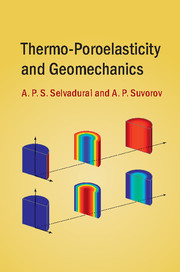Book contents
- Frontmatter
- Dedication
- Contents
- Preface
- Acknowledgements
- 1 Thermo-Poromechanics: Applications and Developments
- 2 Constitutive Relationships Governing Thermo-Poroelastic Processes
- 3 One-Dimensional Problems Involving Thermo-Poroelastic Processes
- 4 Thermo-Poroelasticity of Geomaterial With a Fluid-Filled Rigid One-Dimensional Cavity
- 5 Radially Symmetric Thermo-Poroelasticity Problems for a Solid Cylinder
- 6 Radially Symmetric Thermo-Poroelasticity Problems: Cylindrical Cavity in an Infinite Medium
- 7 Spherically Symmetric Thermo-Poroelasticity Problems for a Solid Sphere
- 8 Spherically Symmetric Thermo-Poroelasticity Problems: Spherical Cavity in an Infinite Medium
- 9 Glaciation Problems Involving Thermo-Poroelastic Processes
- Appendix
- Index
- References
3 - One-Dimensional Problems Involving Thermo-Poroelastic Processes
Published online by Cambridge University Press: 10 November 2016
- Frontmatter
- Dedication
- Contents
- Preface
- Acknowledgements
- 1 Thermo-Poromechanics: Applications and Developments
- 2 Constitutive Relationships Governing Thermo-Poroelastic Processes
- 3 One-Dimensional Problems Involving Thermo-Poroelastic Processes
- 4 Thermo-Poroelasticity of Geomaterial With a Fluid-Filled Rigid One-Dimensional Cavity
- 5 Radially Symmetric Thermo-Poroelasticity Problems for a Solid Cylinder
- 6 Radially Symmetric Thermo-Poroelasticity Problems: Cylindrical Cavity in an Infinite Medium
- 7 Spherically Symmetric Thermo-Poroelasticity Problems for a Solid Sphere
- 8 Spherically Symmetric Thermo-Poroelasticity Problems: Spherical Cavity in an Infinite Medium
- 9 Glaciation Problems Involving Thermo-Poroelastic Processes
- Appendix
- Index
- References
Summary
This chapter examines the thermo-hydro-mechanical problems related to the one-dimensional case of deformation. One-dimensional deformation occurs, for example, in a semi-infinite half-space subjected to uniform stress, fluid pressure and temperature change on its free surface, or in the problem of a uniformly heated fluid layer bounded by two parallel planes which is inserted into an infinitely large poroelastic body. If a poroelastic body has the shape of a cylinder or a column, one-dimensional deformation in such a body can be achieved, for example, by applying uniform stress, fluid pressure and temperature change to its top surface, and setting the displacement, fluid velocity and heat flux normal to the lateral surface of the cylinder to zero.
The problem described in this chapter analyses a cylinder that has a finite height or depth. The lateral surface of this column is restrained from lateral motion, heat and fluid flow, and thus only the axial displacement, axial heat and fluid flow are allowed in this one-dimensional column. The column may be subjected to axial load, fluid pressure and heating applied to its upper surface, and, in addition, the initial fluid pressure and temperature can be applied to the volume of the cylinder. We first solve the thermoelastic problem or thermo-mechanical (TM) problem, where the effect of the fluid pressure is neglected. Then we analyze a hydro-mechanical (HM) problem in which the effect of the temperature change is ignored. Finally, we consider the thermo-hydro-mechanical (THM) problem in which mechanical, hydraulic and thermal effects are taken into account. An analytical solution will be obtained by separation of variables and expanding the unknown fields in Fourier series. The influence of the fluid and solid-phase compressibility on the magnitude of the fluid pressure for the HM and THM problems is underlined. The analytical solution will be compared with the numerical results – a finite element solution obtained using the COMSOL™ finite element program.
Information
- Type
- Chapter
- Information
- Thermo-Poroelasticity and Geomechanics , pp. 60 - 92Publisher: Cambridge University PressPrint publication year: 2016
